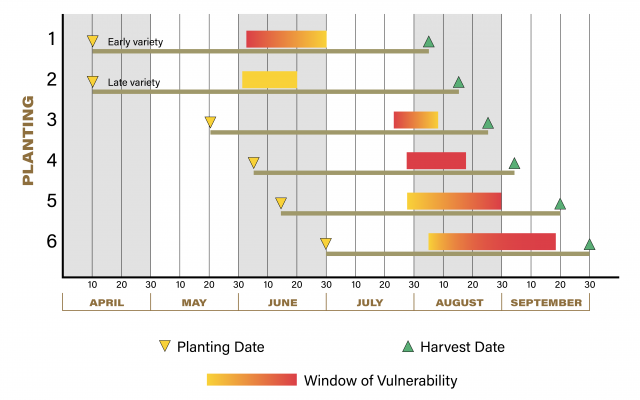The key to successful management of corn earworm (CEW) with insecticide applications is timing. The adult moths deposit eggs on the developing silk. Upon hatching, the larvae follow the silk into the developing ear where they are protected from foliar applications and wreak havoc on your produce. The CEW trapping network is a tool for you to help coordinate the proper timing of insecticide applications, targeting the vulnerable period of egg hatch. Find the trapping location from the list that is closest to your production area. Monitor the counts of adult moths that are captured in the traps and make applications according to the following recommendations:
- If trap catches are 1 moth per night AND fresh silks are present on sweet corn AND neighboring dent corn (field corn) does not have silk present, insecticide applications should be made
- When dent corn is producing fresh silks, apply insecticides on sweet corn when trap catches reach 10 moths per night
- After pollination is complete in dent corn AND fresh silk is present on sweet corn, insecticide applications should be made when trap catches are 1 moth per night
For additional guidelines, see this publication on CEW management in sweet corn.
For hemp producers: There are currently no action thresholds available for CEW in field hemp. However, for the second year of trapping in hemp we will be monitoring in each of the following counties: Jennings, Knox, and Tippecanoe, as a resource for growers to have some warning of CEW activity and pressure. In collaboration with the Office of the Indiana State Chemist, Purdue has worked to develop 24(c) Special Local Needs labels for Venerate® XC, Gemstar® LC, and Agree® WG insecticides for management of CEW in hemp. Refer to the 24(c) label for rates and timing of application for the various products. We do not know how potential pest preferences will drive movement of CEW between corn and hemp, but in 2019 growers reported seeing CEW in their hemp in September and early October. The risk to hemp is infestation in the flowers and buds. Scout your crop if it is flowering AND CEW is being caught in hemp in your area.
Empty cells indicate that a trap was not collected and emptied. A zero in the cell indicates that no moths were captured during the observation period.
